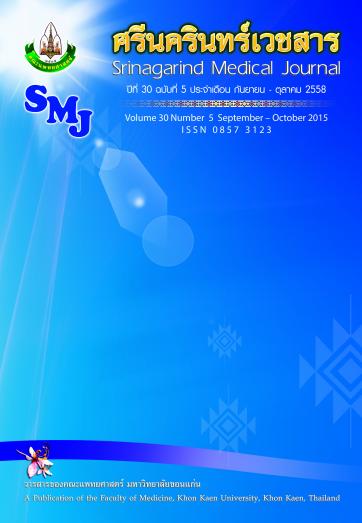Posture and work-related injury in Ban Ngiew’s stone mortar workers, Phayao Province
Keywords:
ergonomics, working posture, work-related injuryAbstract
Background and Objectives: Working posture is one relevant factor of the ergonomics. If the worker represents an awkward working posture such as excessive bending of the part of the body as well as repeat their working motion in high frequency in each working session, they may be had the work-related musculoskeletal injury. The purposes of this study were to assess working posture and work-related musculoskeletal injury in Ban Ngiew’s stone mortar workers, Ban Sang Sub-district, Muang District, Phayao Province.
Methods: This study was a cross-sectional descriptive study, and studied in fifteen male Ban Ngiew’s stone mortar workers. All volunteers were recorded their working motions by digital video cameras in the step of shaping stone mortar by an electric lathe and were recorded their work-related injury by the Standard Nordic Questionnaires. Working motions were evaluated by the Rapid Upper Limb Assessment (RULA) and represented the results in a level of the final score (Level 1-4).
Results: Volunteers had averaged age 43.2 years old and the mean work experience for ten years. For investigating working posture, almost Ban Ngiew’s stone mortar workers (93.34%) shown an awkward posture represented by having the final score in level 3 (66.67%) referring to working posture need to investigate further and change soon and in level 4 (26.67%) referring to working posture need to investigate and implement change. Furthermore, information of the frequency of work-related injury within a previous year shown that all workers (100%) had experienced an injury from work which most occurred on the trunk (32.00%) and the shoulders (32.00%). On the other hand, 20.00 percent of volunteers had a work-related injury within seven days occurred on the lower back (66.67%) and hand (33.33%), respectively.
Conclusion: Working posture of almost Ban Ngiew’s stone mortar workers (93.34%) was an awkward posture, and might be a cause of work-related injury in the musculoskeletal system. Thus, adapted working posture, redesigned workplace and adapted work schedule may be needed for Ban Ngiew’s stone mortar workers. However, for complete evaluation ergonomics factors in the workplace, other factors of the ergonomics should be study.




